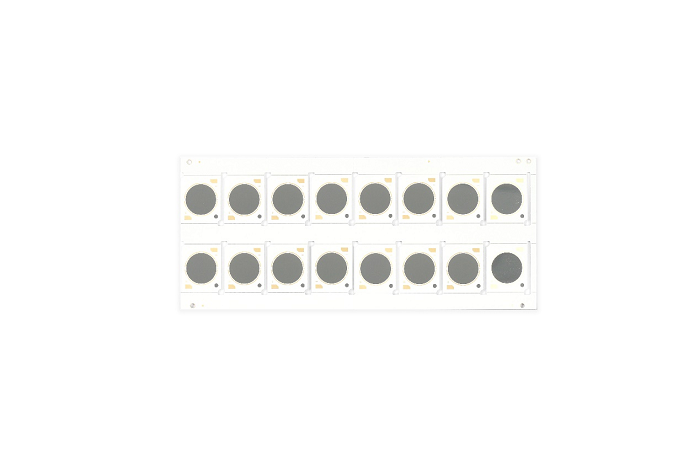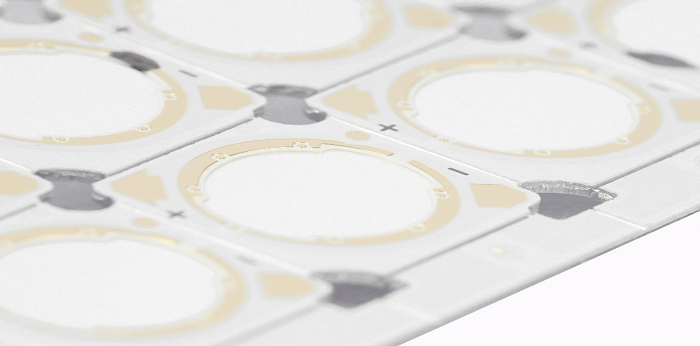Why Choose Aluminum PCB? What’s the Advantage in Audio Equipment Application?
- Views
- 01 Feb 2024
A metal core PCB (Printed Circuit Board) is a type of circuit board that has a metal core, usually made of aluminum, copper alloy, or steel, as its base material instead of the typical fiberglass epoxy substrate found in conventional PCBs. The metal core serves as a heat sink, efficiently dissipating heat generated by the components mounted on the board. Today, we will introduce the aluminum PCB for you.
Choose Aluminum PCB, MCPCB board, aluminum pcb led,
Why Choose Aluminum PCB?
Compared with traditional FR-4, aluminum substrate can reduce thermal resistance to the lowest, making aluminum substrate have excellent thermal conductivity; compared with ceramic substrate, its mechanical performance is also extremely excellent. In addition to good heat dissipation performance, aluminum substrate also has the following advantages:- Compliant with RoHS environmental requirements
- More suitable for SMT process
- Higher current carrying capacity
- In the circuit design scheme, thermal diffusion is dealt with very effectively, thereby reducing the operating temperature of the module, extending the service life, increasing power density and reliability.
- Reduce the assembly of heat sinks and other hardware (including thermal interface materials), reduce product volume, and reduce hardware and assembly costs; optimize the combination of power circuits and control circuits.
- Replace fragile ceramic substrates and obtain better mechanical durability.

What’s the Difference Between Aluminum PCB and FR4 PCB?
While both aluminum PCBs and FR4 PCBs serve the purpose of providing a platform for electronic components, they differ significantly in terms of material composition, heat dissipation capabilities, cost, applications, and mechanical strength. The choice between the two depends on the specific requirements of the electronic device and the intended application.1.Heat Dissipation
The biggest difference between aluminum-clad copper boards and conventional FR-4 clad copper boards lies in heat dissipation. For example, with a thickness of 1.5mm, the thermal resistance of FR-4 clad copper boards is around 20~22°C, while that of aluminum-clad copper boards is much smaller, ranging from 1.0~2.0°C.2.Coefficient of Thermal Expansion
FR-4 boards generally suffer from thermal expansion issues, where high temperatures cause changes in board thickness and flatness, especially in the thickness direction, affecting the quality of metalized holes and circuit lines. The coefficient of thermal expansion of FR-4 board base materials is around 110×10^(-6)cm/cm°C, while aluminum substrate's coefficient of thermal expansion is around 50×10^(-6)cm/cm°C, closer to that of copper foil. This helps ensure the quality and reliability of printed circuit boards.3. Primary Applications:
FR-4 boards are suitable for general circuit designs and ordinary electronic products. While aluminum substrates are suitable for circuits with special requirements, such as thick film hybrid integrated circuits, heat dissipation of power circuits, heat dissipation and cooling of components in circuits, large-scale substrates that ceramic substrates cannot handle, and circuits where reliability issues cannot be solved with ordinary heat sinks.4.Mechanical Machinability
Aluminum PCBs have high mechanical strength and toughness, which is superior to FR-4 boards. Large-area printed boards and heavy components can be installed on such substrates.5.Electrical Performance
Compared to FR-4 boards, the high thermal conductivity of aluminum substrates significantly increases the fuse current of conductors, indicating the high thermal conductivity characteristics of aluminum substrates from another perspective. The thermal conductivity of aluminum substrates is related to the thickness of the insulation layer and thermal conductivity. The thinner the insulation layer, the higher the thermal conductivity of the aluminum substrate (but the lower the withstand voltage performance). Aluminum substrates can act as shielding plates to shield electromagnetic waves and interference, thus ensuring the performance of electronic circuits.6. Insulation Performance
Under normal conditions, the breakdown voltage of aluminum substrates is determined by the thickness of the insulation layer, generally around 500V. If you need to test the breakdown voltage of LED fluorescent lamp aluminum substrates, you only need to perform high-voltage testing on the input port housing. UL and CE certification values should be 2500V, while 3C certification values should be around 3750V.

Applications of Aluminum PCBs
- Lighting products, high-power LED lighting products.
- Audio equipment, preamplifiers, power amplifiers, etc.
- Power equipment, DC/AC converters, rectifier bridges, solid-state relays, etc.
- Communication products, high-frequency amplifiers, filter devices, transmission circuits.
Choose Aluminum PCB, MCPCB board, aluminum pcb led,
Related Blog
- What is Thermal and Electrical Separating Pad in Metal Core PCB?
- LED PCB Assembly Process: Step-by-Step Guide for Beginners
- Why Always Recommend White Solder Mask Black Silkscreen for Aluminum PCB?
- What Materials Are Commonly Used for Manufacturing Lighting PCBs?
- Everything You Should Know About Metal Core Circuit Board
- What Are the Differences Between Ceramic PCB, Metal Core PCB And Standard FR4 PCB?
- Why Choose Best Technology As Your MCPCB Manufacturer?
- What is LED Light Circuit Board and How to Make it?
- When is International Labour Day in 2024 and What are the Significances of It?
- How Does A Convexity Comes Out On Thermoelectric Separation Copper Based PCB?
- Why is Aluminum LED PCB Important for Indoor Growth Lights?
- Application of Metal Core Pcbs in the Development of LED Technology
- Why Choose White Solder Mask for Metal core PCB When Used In LED Devices?
- Understanding Aluminum LED PCBs in 1000w LED Grow Lights
- What Are the Advantages of Metal Core PCB? How to Choose?
- Automotive Light Copper Core Pcb Production Process—testing
- Why Are Metal Core PCBs, Especially Copper Core, Used In Heat-Sensitive Electronics?
- How do aluminum LED PCBs improve LED efficiency?
- What Are the Differences Between Regular and Thermoelectric Separation Copper-Base PCBs?
- Aluminum PCB VS FR-4 Performance Comparison



